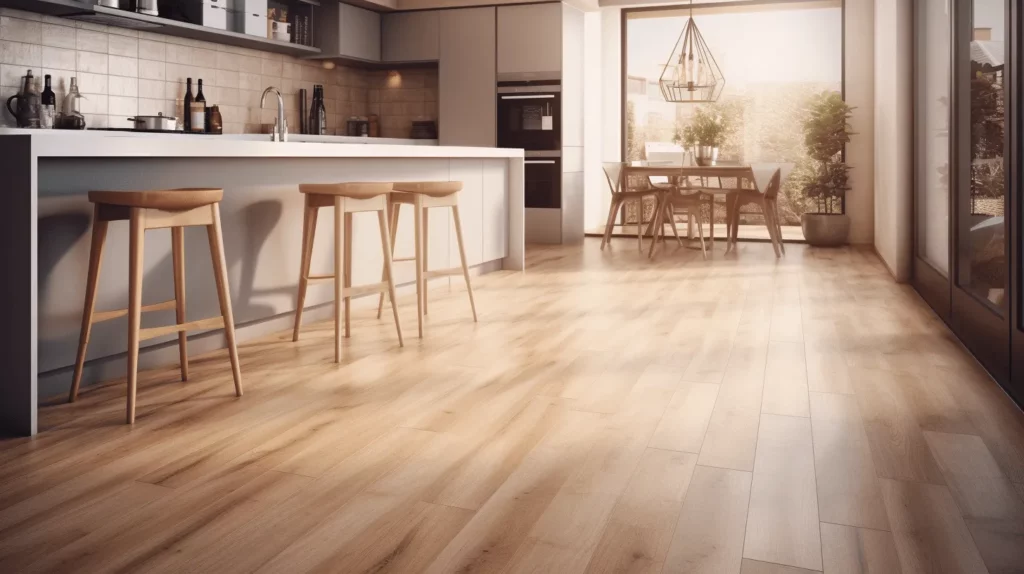Finding alternative kitchen flooring ideas on a budget is a must for some individuals. That is because flooring plays a pivotal role in shaping the ambiance and functionality of our kitchens. So when budget constraints are real, finding the ideal flooring can be challenging. This guide delves deep into alternative kitchen flooring ideas, ensuring your kitchen remains both stylish and wallet-friendly.
Alternative Kitchen Flooring Ideas On A Budget DIY
A kitchen is often considered the heart of a home, bustling with energy and activity. However, a kitchen makeover can quickly deplete your savings if you don’t plan wisely. For those looking to give their kitchen a fresh feel without breaking the bank, DIY flooring solutions offer a perfect blend of creativity, affordability, and practicality. Here are some alternative kitchen flooring ideas that are budget-friendly and will allow homeowners to stamp their signature style on their cooking domain.
Plywood Floors
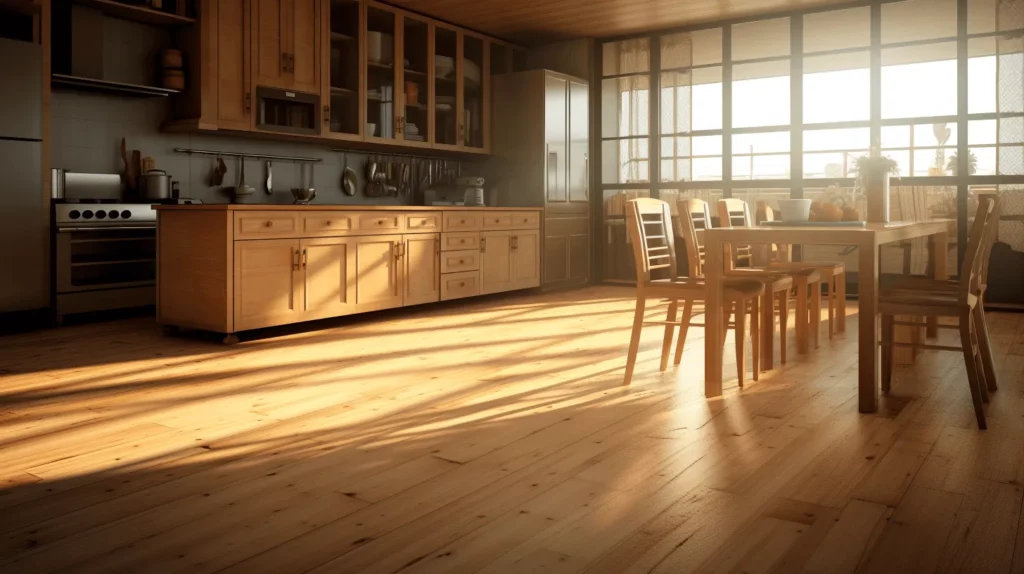

Who said plywood is only for subfloors or construction sites? With a bit of imagination and effort, plywood can be transformed into an aesthetically pleasing kitchen floor. Here’s how:
- Design Flexibility: Plywood sheets can be cut into planks, squares, or any shape you desire. They can be arranged in traditional hardwood patterns, herringbone, or chevron for added flair.
- Finish with Flair: Whether you like the rustic appeal of stained plywood or the sleek look of painted plywood, there’s ample room for customization. Consider sealing with a clear coat to protect against kitchen spills and scuffs.
Peel-and-Stick Vinyl Tiles
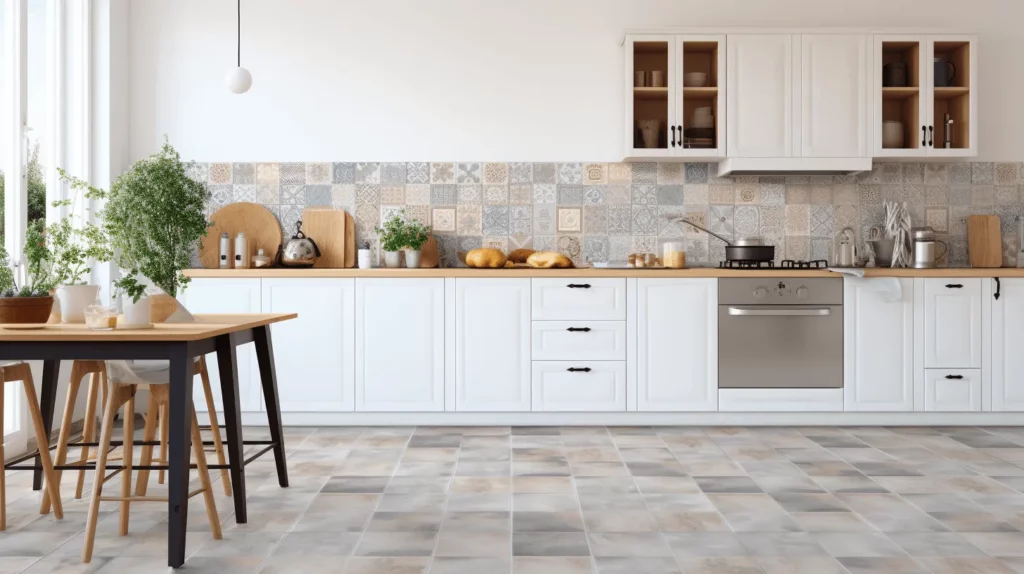

An all-time favorite among DIY enthusiasts, peel-and-stick vinyl tiles provide a quick and hassle-free flooring solution. The advantages are many:
- Variety: Available in countless designs, textures, and colors, from stone to wood and geometric patterns.
- Ease of Application: As the name suggests, you simply peel off the backing and stick the tiles to your floor. Ensure the surface is clean and even for best results.
- Durability: While budget-friendly, these tiles are also water-resistant and fairly durable, making them suitable for a kitchen’s hustle and bustle.
Painted Concrete Floors
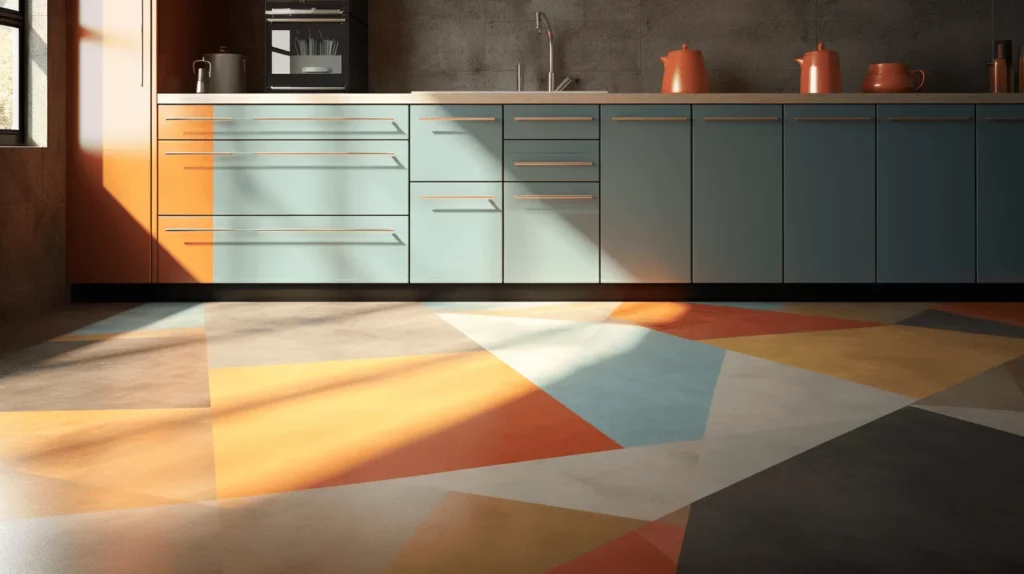

For homes with an existing concrete floor, there’s no need to hide it under layers of other materials. Celebrate it with some paint! Here’s how:
- Preparation is Key: Before painting, ensure the concrete is clean and free of any previous coatings, grease, or oil. Consider using a primer for a smoother finish.
- Designs & Patterns: From stenciled patterns, stripes, to faux stone finishes, your options are limitless. How about a checkerboard pattern or maybe a Mediterranean mosaic feel?
- Seal the Deal: Once your masterpiece is dry, use a sealant to protect against stains and wear.
Alternative Kitchen Flooring Ideas on A Budget
Apart from the DIY options, several affordable yet trendy flooring materials can revamp your kitchen.
Laminate Flooring
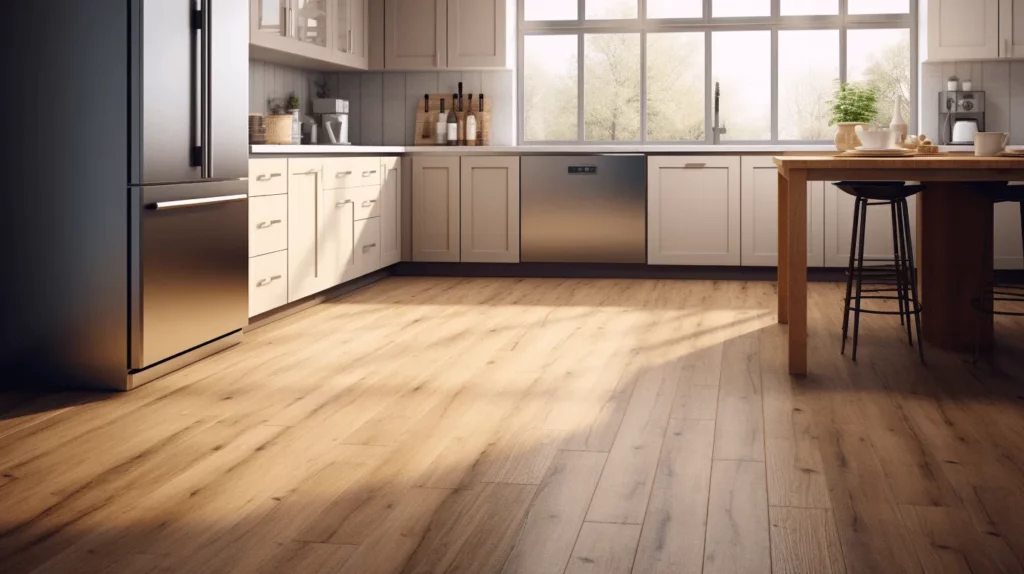

- Visual Appeal: Laminate flooring can convincingly mimic the look of hardwood, stone, or even tile, giving your kitchen a high-end appearance without the hefty price tag.
- Durability: Modern laminates are resistant to stains, impacts, and even UV light. This means they can last for years without fading or showing signs of wear.
- Ease of Installation: Featuring a click-lock design, laminate planks are a favorite among DIYers. No need for adhesives or special tools.
Cork Flooring
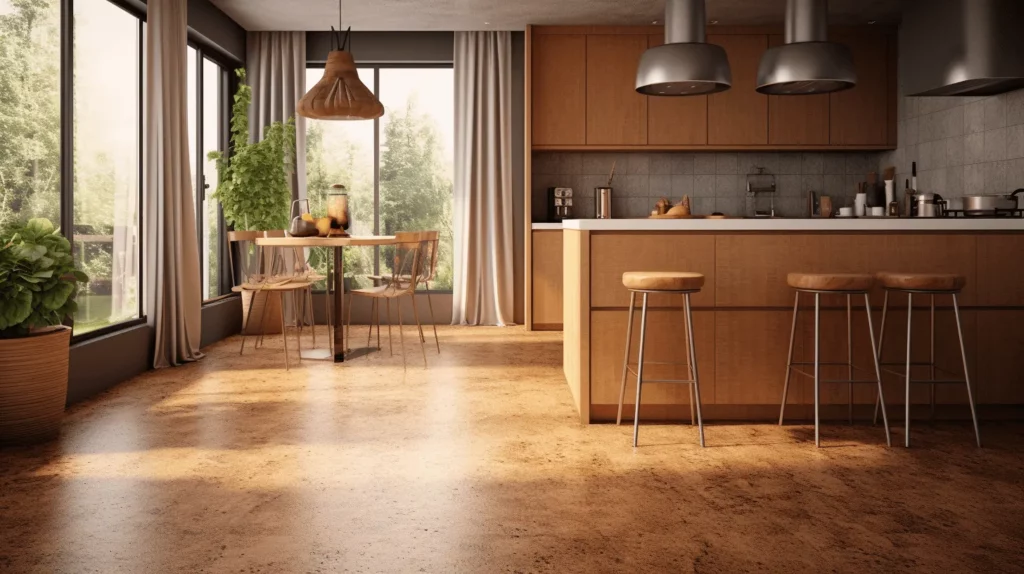

- Eco-friendly: Made from the bark of cork oak trees, this material is sustainable and renewable. Using cork means you’re not depleting forests or harming the environment.
- Comfort: Cork’s soft and springy nature makes it comfortable to stand on— a boon for those who spend a lot of time cooking or entertaining in the kitchen.
- Unique Look: With its distinct texture and natural patterns, cork adds warmth and a unique style to any kitchen.
Linoleum Flooring
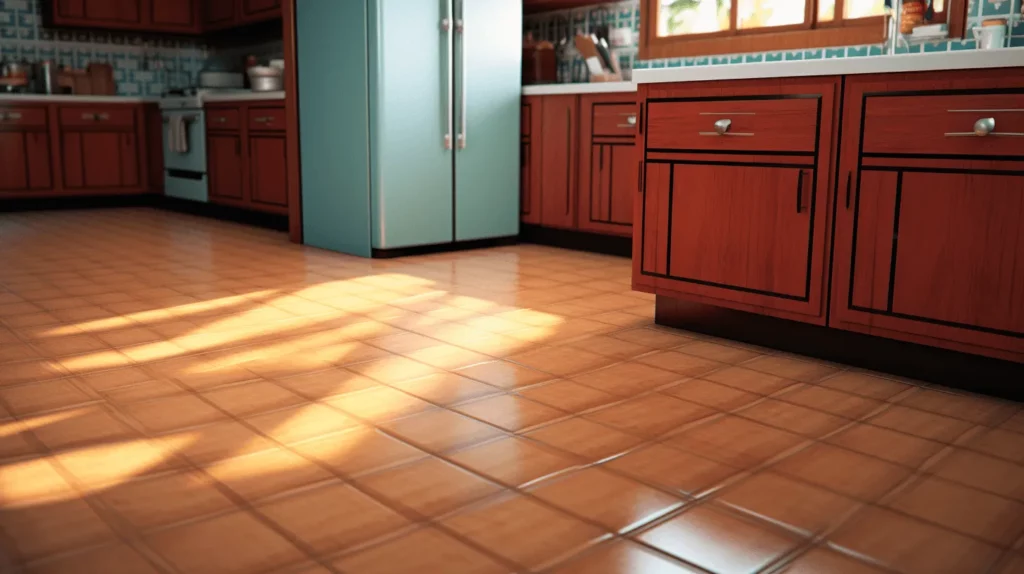

- Natural Origins: Made from linseed oil, pine resin, cork dust, wood flour, and mineral fillers, linoleum is biodegradable and eco-friendly.
- Versatility: Available in sheets, tiles, or planks, linoleum comes in a plethora of colors, patterns, and designs. Whether you’re aiming for a retro vibe or a contemporary look, there’s a linoleum for you.
- Low Maintenance: Linoleum floors are easy to clean and resistant to water, making them perfect for spill-prone areas like the kitchen.
Ceramic Tiles Flooring
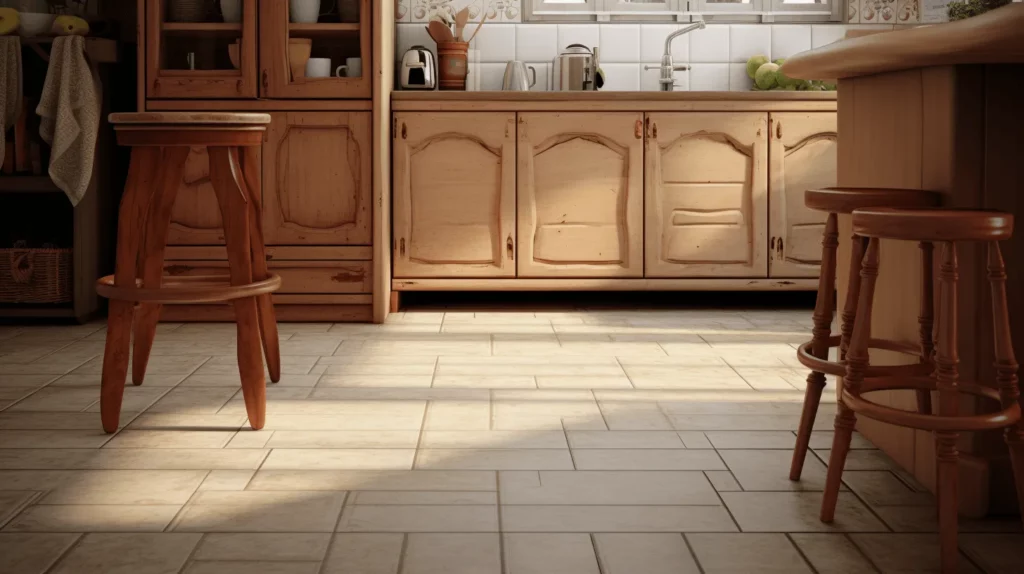

- Options Galore: Ceramic tiles range from basic to ornate, allowing homeowners to pick styles that fit their budget. Basic ceramic tiles can be as cost-effective as they are stylish.
- Durability: Ceramic is tough, resisting most dents, dings, and moisture. With proper care, these tiles can last for decades.
- Design Flexibility: Whether you’re going for a monochromatic scheme, intricate patterns, or even a mosaic, ceramic tiles provide unmatched design flexibility.
Pros and Cons of Budget Flooring
Budget flooring options have become increasingly popular as homeowners and property managers seek cost-effective solutions that don’t compromise too much on aesthetics or functionality. However, as with all things, budget flooring comes with its share of pros and cons. Here’s a detailed exploration of the advantages and disadvantages of popular budget flooring options:
Laminate Flooring
Pros:
- Visual Versatility: Laminate flooring can closely mimic the look of hardwood, stone, or tile without the hefty price tag.
- Ease of Installation: Designed for DIY installations, most laminate systems utilize a click-lock design, reducing installation costs.
- Low Maintenance: Laminate is easy to clean, often only requiring regular sweeping and occasional mopping.
- Stain Resistance: Modern laminates resist stains quite well, which can be particularly useful in high-traffic areas.
Cons:
- Durability Limitations: While they resist scratches and dents to a degree, laminates can be damaged by sharp objects.
- Water Sensitivity: Prolonged exposure to water can cause laminate boards to warp or swell.
- Lifespan: Laminates generally have a shorter lifespan compared to traditional hardwood.
Cork Flooring
Pros:
- Eco-friendly: Derived from the bark of cork oak trees, it’s a sustainable and renewable resource.
- Comfort: The soft texture of cork provides cushioning, making it comfortable to stand on for extended periods.
- Insulation: Cork offers natural insulation, keeping your space warmer in winter and cooler in summer.
- Sound Absorption: The structure of cork can help reduce noise, making spaces quieter.
Cons:
- Maintenance: Cork floors might need periodic resealing to prevent damage from moisture and UV rays.
- Durability: While cork is somewhat resilient, it can be dented by heavy furniture or high heels.
- Variability: Natural variations in cork might make it challenging to achieve a consistent look across a large area.
Linoleum Flooring
Pros:
- Natural Composition: Made from linseed oil, pine resin, and other natural components, linoleum is eco-friendly and biodegradable.
- Health: It’s non-toxic and can resist bacterial growth, making it a healthy flooring option.
- Durability: With proper care, linoleum can be long-lasting and resist scratches and dents.
Cons:
- Installation: Installing linoleum might be more challenging than other budget flooring options, often requiring professional help.
- Maintenance: Linoleum can require periodic waxing or polishing to maintain its shine.
- Susceptibility: Without proper sealing, it can be susceptible to moisture damage.
Painted Concrete
Pros:
- Durability: Concrete is robust and long-lasting, resisting wear over many years.
- Versatility: With a myriad of paint colors and techniques available, homeowners can achieve a variety of looks ranging from sleek and modern to rustic.
- Low Maintenance: Once sealed, painted concrete is easy to clean, typically needing only regular sweeping and occasional mopping.
- Cooling Effect: In warmer climates, concrete floors can help keep spaces cooler.
Cons:
- Hard Surface: Concrete is unforgiving on the joints and can be uncomfortable to stand on for prolonged periods.
- Temperature Sensitivity: In colder climates, concrete can feel cold underfoot unless heated.
- Moisture Vulnerability: If not sealed properly, concrete can be prone to moisture, leading to potential mold problems or paint peeling.
Plywood Floors
Pros:
- Affordability: Plywood is considerably cheaper than traditional hardwood flooring.
- Customizability: Plywood can be stained, painted, or sealed to achieve a wide range of looks.
- Easy Installation: With basic tools, plywood can be a DIY-friendly flooring option.
- Warmth: Plywood offers a warmer underfoot feel compared to options like tile or concrete.
Cons:
- Durability Concerns: Plywood is more susceptible to dents, scratches, and wear compared to solid hardwood.
- Moisture Sensitivity: Without proper sealing, plywood can absorb moisture and warp.
- Finish Inconsistencies: Depending on the plywood’s quality, achieving a consistent finish can sometimes be challenging.
Peel-and-Stick Vinyl Tiles
Pros:
- Ease of Installation: As the name suggests, installation involves simply peeling the backing and sticking the tiles in place.
- Design Variety: These tiles are available in an array of designs, from wood-look to ceramic-look, offering versatility in aesthetic choices.
- Water Resistance: Vinyl tiles can handle moisture, making them suitable for kitchens or bathrooms.
- Budget-Friendly: Among the most affordable flooring options, these tiles offer good value for the cost.
Cons:
- Durability Concerns: Peel-and-stick tiles might not withstand heavy foot traffic as well as other flooring options.
- Subfloor Sensitivity: The appearance and adherence of the tiles can be affected by the condition of the subfloor. Imperfections can sometimes show through.
- Limited Lifespan: Over time, these tiles can fade, wear out, or lift at the edges.
Maintaining Your Budget Kitchen Floor
Your budget-friendly kitchen floor can look great and last longer with the right care. Start by sweeping daily to remove dirt and grit; these can act as abrasives, causing unnecessary wear. When it’s time to mop, use a damp (not wet) mop to avoid excessive moisture which can damage certain floor types.
For tougher stains, a mild cleaner suitable for your specific flooring type can be a lifesaver. Moreover, consider using protective pads under furniture legs to reduce scratches. Rugs or mats in high traffic areas can minimize wear, but ensure they have a non-slip underside for safety. Lastly, always refer to the manufacturer’s guidelines. These tailored tips ensure your floor remains in optimal condition, ensuring your budget choice offers excellent value for years to come.
The Environmental Aspect
In today’s world, where sustainability is paramount, making eco-friendly choices in home design is more crucial than ever. Cork stands out, sourced from the renewable bark of the cork oak tree without harming the tree itself. This makes cork a renewable resource, with the added benefit of being biodegradable at the end of its lifespan.
Linoleum, on the other hand, is crafted from a concoction of natural materials like linseed oil, pine resin, and cork dust. Not only is linoleum biodegradable, but its production also has a lower environmental impact compared to many synthetic counterparts.
Wrapping It Up: Alternative Kitchen Flooring Ideas On A Budget
While hardwood and marble floors might be dreamy, they aren’t the only options. With a touch of creativity, even budget-friendly alternatives can transform your kitchen into a beautiful and functional space.
FAQs
Is laminate flooring durable for kitchens?
While not as durable as hardwood, with proper care, laminate can last for several years.
Can I install these floors myself?
Many of these options, especially peel-and-stick tiles and laminate, are DIY-friendly.
How do I clean and maintain cork floors?
Regular sweeping and occasional damp mopping with a mild detergent should do the trick.
Are these budget-friendly options water-resistant?
Materials like ceramic tiles are water-resistant, but others like laminate and cork might require sealing to prevent water damage.
How long will these budget-friendly floors last?
With proper care and maintenance, these floors can last anywhere from 10 to 20 years.
Investing in the right kitchen floor doesn’t have to break the bank. With the numerous alternative kitchen flooring ideas available, your dream kitchen is just a choice away!

